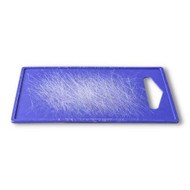The Dangers of Resurfacing Your HDPE Cutting Board
26th Apr 2022
In the food service industry, our equipment goes through a lot of wear and tear. One of the most frequently asked questions we get here at Cooler Gaskets is whether it is safe to resurface plastic or poly cutting boards by sanding them down. While it may seem like an easy fix and a good way to save a few bucks here and there, you should never resurface a plastic or poly cutting board by sanding it down.
Our ultimate answer to why you should never resurface a HDPE (High-Density Polyethylene) or plastic cutting board is that it’s unsafe for both your kitchen staff as well as the customers consuming the food that is prepared on a resurfaced cutting board. Here’s why:
You Lose the Necessary Texture of the Cutting Board
All HDPE cutting boards are made with a semi-rough texture on one side of the board, which you can feel upon receiving a brand new cutting board. This texture is there to essentially hold your food in place while you are cutting it and prevent it from sliding across the board, especially when you have slippery foods such as raw meat or freshly washed fruits and vegetables. Losing that texture could result in food sliding off the board- which is ultimately another cost to you as a business owner.
Knife Safety 101
Another reason that poly or plastic cutting boards are made with a semi-rough texture on one side of the board is to help catch your knife when you are prepping food. A knife is only as good as its cutting board, and if the cutting board’s texture is compromised, it is more likely for your knives to slip on the board. This could lead to all kinds of dangers in the kitchen, the least being cuts on your fingers or hands.
Big Bad Bacteria
The whole idea behind sanding or resurfacing a cutting board is to clean the surface of the board, right? The problem is that sanding down a plastic or poly cutting board actually does the opposite. You may be getting rid of the larger knife marks, but a sander will create very small cuts on the board that food particles can get trapped in and very difficult to get out. In fact, even your commercial dishwasher could miss these tiny food particles now stuck in your cutting board which will then grow bacteria over time. Needless to say, bacteria in and on your cutting boards will then lead to contamination of the food being prepped on it.
All that to say: when your cutting boards are on their last leg, the best thing to do is to go ahead and place a replacement order for your plastic or poly cutting boards. Here at Cooler Gaskets, we have a team in our Atlanta warehouse that makes HDPE to order that are NSF certified and exactly the size and dimensions you need. We offer both standard sized cutting boards as well as custom cutting boards to fit your every need.
Have questions or want more information? Call our customer service team anytime from 8am - 5pm EST at 855-288-2259.

